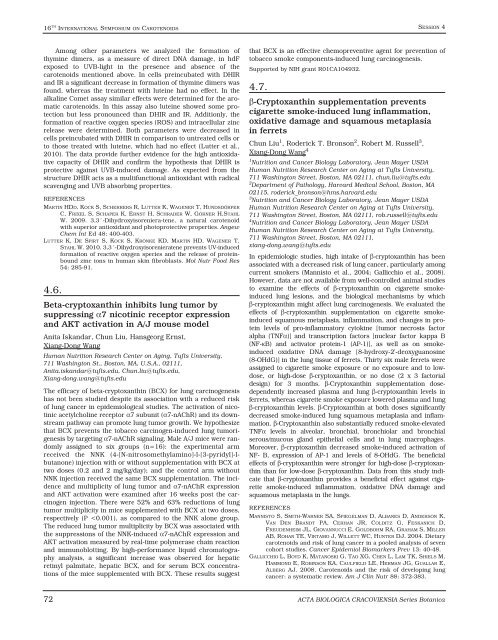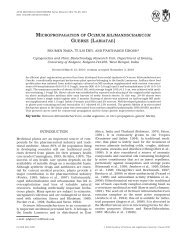ACTA BIOLOGICA CRACOVIENSIA
ACTA BIOLOGICA CRACOVIENSIA
ACTA BIOLOGICA CRACOVIENSIA
You also want an ePaper? Increase the reach of your titles
YUMPU automatically turns print PDFs into web optimized ePapers that Google loves.
16 TH INTERNATIONAL SYMPOSIUM ON CAROTENOIDS<br />
Among other parameters we analyzed the formation of<br />
thymine dimers, as a measure of direct DNA damage, in hdF<br />
exposed to UVB-light in the presence and absence of the<br />
carotenoids mentioned above. In cells preincubated with DHIR<br />
and IR a significant decrease in formation of thymine dimers was<br />
found, whereas the treatment with luteine had no effect. In the<br />
alkaline Comet assay similar effects were determined for the aromatic<br />
carotenoids. In this assay also luteine showed some protection<br />
but less pronounced than DHIR and IR. Additionly, the<br />
formation of reactive oxygen species (ROS) and intracellular zinc<br />
release were determined. Both parameters were decreased in<br />
cells preincubated with DHIR in comparison to untreated cells or<br />
to those treated with luteine, which had no effect (Lutter et al.,<br />
2010). The data provide further evidence for the high antioxidative<br />
capacity of DHIR and confirm the hypothesis that DHIR is<br />
protective against UVB-induced damage. As expected from the<br />
structure DHIR acts as a multifunctional antioxidant with radical<br />
scavenging and UVB absorbing properties.<br />
REFERENCES<br />
MARTIN HDD, KOCK S, SCHERRERS R, LUTTER K, WAGENER T, HUNDSDÖRFER<br />
C, FRIXEL S, SCHAPER K, ERNST H, SCHRADER W, GÖRNER H,STAHL<br />
W. 2009. 3,3´-Dihydroxyisoreniera-tene, a natural carotenoid<br />
with superior antioxidant and photoprotective properties. Angew<br />
Chem Int Ed 48: 400-403.<br />
LUTTER K, DE SPIRT S, KOCK S, KRÖNKE KD, MARTIN HD, WAGENER T,<br />
STAHL W. 2010. 3,3´-Dihydroxyisorenieratene prevents UV-induced<br />
formation of reactive oxygen species and the release of proteinbound<br />
zinc ions in human skin fibroblasts. Mol Nutr Food Res<br />
54: 285-91.<br />
4.6.<br />
Beta-cryptoxanthin inhibits lung tumor by<br />
suppressing α7 nicotinic receptor expression<br />
and AKT activation in A/J mouse model<br />
Anita Iskandar, Chun Liu, Hansgeorg Ernst,<br />
Xiang-Dong Wang<br />
Human Nutrition Research Center on Aging, Tufts University,<br />
711 Washington St., Boston, MA, U.S.A., 02111,<br />
Anita.iskandar@tufts.edu, Chun.liu@tufts.edu,<br />
Xiang-dong.wang@tufts.edu<br />
The efficacy of beta-cryptoxanthin (BCX) for lung carcinogenesis<br />
has not been studied despite its association with a reduced risk<br />
of lung cancer in epidemiological studies. The activation of nicotinic<br />
acetylcholine receptor α7 subunit (α7-nAChR) and its downstream<br />
pathway can promote lung tumor growth. We hypothesize<br />
that BCX prevents the tobacco carcinogen-induced lung tumorigenesis<br />
by targeting α7-nAChR signaling. Male A/J mice were randomly<br />
assigned to six groups (n=16): the experimental arm<br />
received the NNK (4-[N-nitrosomethylamino]-l-[3-pyridyl]-lbutanone)<br />
injection with or without supplementation with BCX at<br />
two doses (0.2 and 2 mg/kg/day); and the control arm without<br />
NNK injection received the same BCX supplementation. The incidence<br />
and multiplicity of lung tumor and α7-nAChR expression<br />
and AKT activation were examined after 16 weeks post the carcinogen<br />
injection. There were 52% and 63% reductions of lung<br />
tumor multiplicity in mice supplemented with BCX at two doses,<br />
respectively (P












